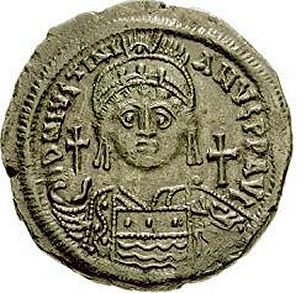Volume One
Ancient and Medieval States
Background
Bureaucratic Empires: China
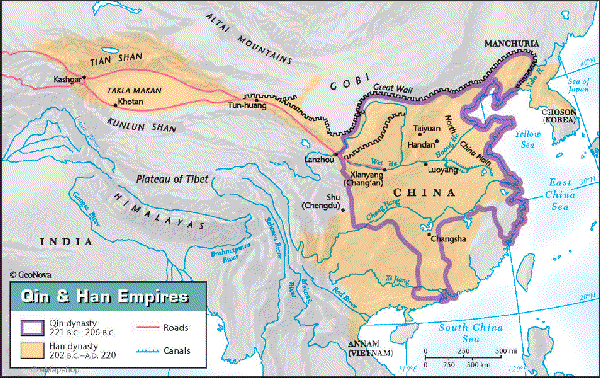 Throughout its imperial history, from the Qin (221-206 BC) to the Qing (AD 1644-1911) dynasties, China was governed as a centralized bureaucracy. {1-2} Everything — public works, irrigation, roads, canals, security, administration of the towns and cities, law and justice, and frontier security — was supervised by various grades of officials who reported to ministers and thence to the emperor, who held the 'mandate of heaven'. {3} Until 700 AD, the more important officials were generally nobles or relatives of the emperor, but from Tang times the bulk were selected by the imperial examination system theoretically open to all, i.e. appointment was on merit. {4} Most emperors took their duties seriously, particularly those of the early Qing dynasty (1662-1796) who were exceptionally sensible, hard-working and long-lived rulers. The Chinese civil-service system gave the Chinese empire stability for more than 2,000 years and provided one of the major outlets for social mobility, serving as a model for the later civil-service systems in other Asian and western countries.
Throughout its imperial history, from the Qin (221-206 BC) to the Qing (AD 1644-1911) dynasties, China was governed as a centralized bureaucracy. {1-2} Everything — public works, irrigation, roads, canals, security, administration of the towns and cities, law and justice, and frontier security — was supervised by various grades of officials who reported to ministers and thence to the emperor, who held the 'mandate of heaven'. {3} Until 700 AD, the more important officials were generally nobles or relatives of the emperor, but from Tang times the bulk were selected by the imperial examination system theoretically open to all, i.e. appointment was on merit. {4} Most emperors took their duties seriously, particularly those of the early Qing dynasty (1662-1796) who were exceptionally sensible, hard-working and long-lived rulers. The Chinese civil-service system gave the Chinese empire stability for more than 2,000 years and provided one of the major outlets for social mobility, serving as a model for the later civil-service systems in other Asian and western countries.
The Qin dynasty (221-207 BC) established the first centralized Chinese bureaucratic empire. Recruitment was based on recommendations by local officials, a system initially adopted by the succeeding Han dynasty. But in 124 BC, under the reign of the Han emperor Wudi, an imperial university was established to train and test officials in the techniques of Confucian government. The Sui dynasty (581-618 AD) adopted this Han system, but applied it much more systematically, adding rules that officials of a prefecture must be appointees of the central government rather than local aristocrats, and that the local militia were to be subject to officials of the central government. The Tang dynasty (618-907 AD) created a system of local schools where scholars could pursue their studies, and this system gradually became the major method of recruitment into the bureaucracy. By the end of the Tang dynasty, the old aristocracy had largely disappeared, and their position was taken by the scholar-gentry. This nonhereditary elite would eventually become known to the west as 'mandarins', a reference to Mandarin, the dialect of Chinese they spoke. The civil-service system expanded to its highest point during the Song dynasty (960-1279 AD). Public schools were established throughout the country to help the talented but indigent, business contact was barred among officials related by blood or marriage, relatives of the imperial family were not permitted to hold high positions, and promotions were based on a merit system in which a person who nominated another for advancement was deemed entirely responsible for that person's conduct. The higher levels of the bureaucracy required passing the jinshi degree, and after 1065 the examinations were held every three years for those who had passed qualifying tests on the local level. {5-6}
Under the Ming dynasty (1368-1644 AD), the civil-service system reached its final form, and the succeeding Qing dynasty (1644-1911) virtually copied the Ming system wholesale. No man was allowed to serve in his home district, and official's positions were rotated every three years. The recruitment exam was divided into three stages, but only achieving the jinshi made one eligible for high office. Other degrees gave one certain privileges, such as exemption from labour service and corporal punishment, government stipends, and admission to upper-gentry status (juren). Elaborate precautions were taken to prevent cheating, different districts in the country were given quotas for recruitment into the service to prevent the dominance of any one region, and the knowledge tested became limited to the Nine Classics of Confucianism. As such, it bore no relation to the candidate's ability to govern and was often criticized for setting a command of style above thought. The examination system was finally abolished in 1905 by the Qing dynasty, which was itself overthrown in 1911-12. {7}
Governance in early China
To the wise and subtle government of imperial China there were always two threats. One came from the top, from the inner sanctum of ministers attending the emperor, where rivalries or or ill-thought-out ideas of agrarian reform could unsettle the traditional ways of the Chinese peasant and imperil the empire at large. China had rich farmers and prosperous merchants, and the life-styles of civil servants high in the bureaucracy could be astonishly lavish, but the economic backbone lay in the millions of its poorer peasants, who tilled the rice paddies and just about survived.
The second threat came from natural disasters. Rice was stored to cover bad harvests, and irrigation systems carefully maintained, but there was a limit to preparedness. Epidemics were as widespread as those in Europe, and no better handled, though there were none of the disgraceful progroms or burning of witches. But against the flooding of the Yellow River, aptly called 'China's sorrow', there was no final protection. Levees were built up, but could be breached by a river swollen by unseasonable rains, when vast areas parts of low-lying China would be flooded. Millions displaced and starving were millions who could overturn the best of government machinery, and the fear then, as it is today, is widespread social disorder that turns to revolution. Wang Mang's usurping government suffered both calamities.
Wang Mang and the Xin Dynasty: AD 7-23
Throughout its population growth from 18 to 58 millions {1-2}, the prosperous western Han dynasty (206 BC to AD 7) used three denominations only — first the 'ban liang' (half ounce or twelve 'zhu'), then, from 118 to 115 BC the 'wu zhu' (five 'zhu') and, intermittently, the scarce 'san' 'zhu' (three zhu: not shown). Gold was used for making large payments, especially abroad, and as a store of value, but it did not circulate. {7}
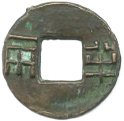 Weights, sizes and calligraphy of cash pieces could vary a little, probably depending on period, province and metal supplies, but all three coins were standardized, and stoutly cast in copper with some admixture of tin, lead and iron. {3} Some 220 million 'ban-liangs' were cast every year, {4} and served the full breadth of Chinese society — for payment of taxes on wealth and business, for officials’ salaries, and for food and other purchases. Millet sufficient to feed a family for a month cost 75 cash, for example, and a labourer could be hired for 150 cash a month. At the other end of the spectrum, beyond the wildest dreams of villagers, a horse cost 4,400-4,500 cash. The poll tax for most adults was 120 coins annually, 240 coins for merchants, and 20 coins for minors. {2,5} At average rates of population growth and wealth, each Chinese would have handled one to two thousand cash a year — a crude simplification, but sufficient to show how widely employed were these simple coins. China’s vast peasant population depended on them for their everyday needs, and a contented peasantry made for a contented country. All this the enterprising Wang Mang {6} managed to confound.
Weights, sizes and calligraphy of cash pieces could vary a little, probably depending on period, province and metal supplies, but all three coins were standardized, and stoutly cast in copper with some admixture of tin, lead and iron. {3} Some 220 million 'ban-liangs' were cast every year, {4} and served the full breadth of Chinese society — for payment of taxes on wealth and business, for officials’ salaries, and for food and other purchases. Millet sufficient to feed a family for a month cost 75 cash, for example, and a labourer could be hired for 150 cash a month. At the other end of the spectrum, beyond the wildest dreams of villagers, a horse cost 4,400-4,500 cash. The poll tax for most adults was 120 coins annually, 240 coins for merchants, and 20 coins for minors. {2,5} At average rates of population growth and wealth, each Chinese would have handled one to two thousand cash a year — a crude simplification, but sufficient to show how widely employed were these simple coins. China’s vast peasant population depended on them for their everyday needs, and a contented peasantry made for a contented country. All this the enterprising Wang Mang {6} managed to confound.
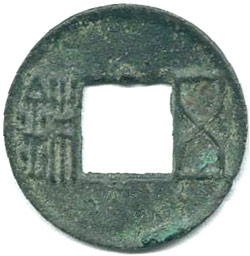 As the new emperor, he instituted land reform, claiming all land henceforth belonged to the empire, and should be redistributed more equitably. A ‘sloth’ tax punished those unwilling to work, or who left land uncultivated. He set up a state economic adjustment board to control prices of food and textiles. He abolished slavery, imposed an income tax, and set up state monopolies on liquor, salt, iron, coinage, forestry, and fishing. And to mark a new economic order, he introduced a new system of coinage. The 'wu zhu' was retained, but to it in AD 7 was added a 'da quan wu zhu', worth a nominal 50 'wu zhu', and the beautiful 'yi da ping wu qian' knife coin with gold-inlaid characters, today a treasured collector’s item, but then worth a nominal five thousand 'zhu'. But who was going to exchange real goods for such an arbitrary denomination, by fiat imposed and no doubt as quickly disavowed? Two years later came a yet more bewildering system of tortoise shells, cowries, gold, silver, round copper coins and a further knife coin. {3} The peasants naturally refused denominations so easily counterfeited, and the coins did not circulate, even at the threat of immediate exile to China’s borders. {7} But trade and farming were badly damaged, and all such innovations had to be withdrawn in AD 14, to be replaced by two other coins, a new type of knife and a round coin. But the country had been turned upside down enough, and in the unrest that followed the floodings of the Yellow River and consequent famines, Wang Mang’s Xin dynasty was overthrown.
As the new emperor, he instituted land reform, claiming all land henceforth belonged to the empire, and should be redistributed more equitably. A ‘sloth’ tax punished those unwilling to work, or who left land uncultivated. He set up a state economic adjustment board to control prices of food and textiles. He abolished slavery, imposed an income tax, and set up state monopolies on liquor, salt, iron, coinage, forestry, and fishing. And to mark a new economic order, he introduced a new system of coinage. The 'wu zhu' was retained, but to it in AD 7 was added a 'da quan wu zhu', worth a nominal 50 'wu zhu', and the beautiful 'yi da ping wu qian' knife coin with gold-inlaid characters, today a treasured collector’s item, but then worth a nominal five thousand 'zhu'. But who was going to exchange real goods for such an arbitrary denomination, by fiat imposed and no doubt as quickly disavowed? Two years later came a yet more bewildering system of tortoise shells, cowries, gold, silver, round copper coins and a further knife coin. {3} The peasants naturally refused denominations so easily counterfeited, and the coins did not circulate, even at the threat of immediate exile to China’s borders. {7} But trade and farming were badly damaged, and all such innovations had to be withdrawn in AD 14, to be replaced by two other coins, a new type of knife and a round coin. But the country had been turned upside down enough, and in the unrest that followed the floodings of the Yellow River and consequent famines, Wang Mang’s Xin dynasty was overthrown.
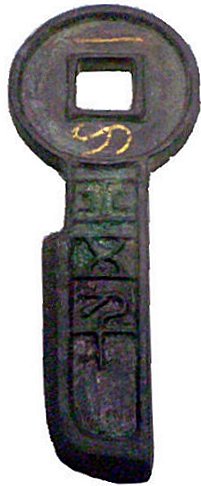 Much is contradictory about Wang. {6} He was born on the edges of the royal family in a far from lucrative or influential position. Appearing an honest and abstemious official, his conspicuous Confucian virtues promoted him first to imperial attendant and then a sub-commander of the imperial guards. Impressed by his reputation, the emperor then made him Marquess of Xindu and Chamberlain for Attendants. The higher the post Wang was promoted to, the more humble he appeared. Wealth he gave away to scholars and colleagues, and the modest official was renowned for having only one wife and no concubines. In 8 BC, at the age of 37, having contrived to have his rival executed for treason, Wang Mang was made commander of the armed forces. To this post he brought self-discipline, capacity and intelligence, promoting officers for ability more than social connections.
Much is contradictory about Wang. {6} He was born on the edges of the royal family in a far from lucrative or influential position. Appearing an honest and abstemious official, his conspicuous Confucian virtues promoted him first to imperial attendant and then a sub-commander of the imperial guards. Impressed by his reputation, the emperor then made him Marquess of Xindu and Chamberlain for Attendants. The higher the post Wang was promoted to, the more humble he appeared. Wealth he gave away to scholars and colleagues, and the modest official was renowned for having only one wife and no concubines. In 8 BC, at the age of 37, having contrived to have his rival executed for treason, Wang Mang was made commander of the armed forces. To this post he brought self-discipline, capacity and intelligence, promoting officers for ability more than social connections.
The Emperor Cheng died suddenly in 7 BC, and his nephew Crown Prince Lui Xin ascended the dragon throne. Wang Mang remained in position, as powerful as ever, at least until he clashed with the ambitious Empress Dowager Fu, when he quietly resigned his post and was careful to take no further part in politics. He stayed a popular figure with the new emperor, however, who indeed received constant petitions for Wang Mang’s return to the capital. But in 1 BC, the new emperor also died, suddenly and without naming an heir. Grand Empress Dowager Wang seized the moment, summoned Wang Mang back to Chang’an, and put him in charge of the army and government. The infant Crown Prince Jizi of Zhongshan became the Emperor Ping, and Wang Mang was installed as regent.
Perhaps with no alternative, Wang moved swiftly to remove opposition. Threatening members of the royal family were demoted, graves of past rivals were desecrated, hostile officials relieved of their posts, and a personality cult encouraged to make Wang the inheritor of Zhou prophecies. He assumed an unheard-of title, the Duke of Anhan, and married his daughter to the Emperor Ping. In 3 AD, discovering dissent against his over-reaching policies in the person of his own son Wang Yu, he had the son commit suicide, the plotters tortured, and their extended families exterminated. When, in 5 AD, the young emperor seemed to be outgrowing his heart condition, and so likely to elude his tutelage, Wang had the 13 year-old-boy poisoned with spiked wine. There were certainly more legitimate successors, but the regent, in his new role of ‘acting emperor’, selected the one-year-old Yin, giving him the title crown prince only, rather than emperor. Wang also re-instituted the five grades of nobility of the old Zhou dynasty, suspiciously it seemed to the imperial Liu clan, who instigated several revolts. The ease with which Wang eliminated rivals persuaded him to take the mandate of heaven himself. So was created the new Xin Dynasty. In twenty years of dissimulation and aspiring ability, Wang Mang had undone the most rationally-governed country on earth.
Thereafter it was not plain sailing, or even sensible sailing. Wang antagonized the Xiongnu, those threatening Turcomen tribesman previously bought off with tributes and titles. He required that their leader, Chanyu Zhi, return Wuhan hostages he had taken in lieu of tribute, and accept a new seal that reduced their title from ‘ferocious slave’ to ‘respectful slave’. Chanyu Zhi therefore prepared for war, but the emperor struck first. He had Chanyu’s sons kidnapped, and eventually executed, though the northern provinces suffered Xiongnu reprisals, which did not endear Wang to his people. To the south-western tribes, Wang was no more conciliatory, again stirring up rebellion by needlessly demoting their leaders. Similar policies to Korean tribes and the Xiyu kingdoms brought the same result: rebellions and hardships for the Chinese living in the border regions.
But Wang demanded more than submission of surrounding regions in the old Zhou manner. He wanted China itself to return to Zhou standards, and spent much time having the ancient systems researched and implemented. Or not implemented. Wang often avoided delegating, employed eunuchs, and refused to pay salaries until the new order was established, something that took years to achieve. In the meantime, officials had to live, and corruption became inevitable. Not until 16 AD did Wang finally settle on a new salary system, which was to depend on the prosperity of the state, a highly contentious and subjective matter.
Civil order was severely tested by these policies, but held until AD 11, when the Yellow River overflowed its banks and precipitated a famine in Jing Prefecture (modern Hubei, Hunan and southern Henan). Wars, corruption and hunger slowly took their toll. By AD 17, rebellions had become widespread, but Wang still put them down by force. Peace overtures by the Xiongnu he spurned in AD 18, and changed the heir presumptive two years later, weakening unity in the Wang family. Agrarian revolts were now serious, and the peasant armies won important victories over government forces in Nanyang.
At last, early in AD 23, Liu Xuan proclaimed himself Emperor Gengshi of the new Han dynasty. The rebels were in fact far from united, but later that year disposed of an army of 43,000 sent against them. Lui Xuan now sent his own army against Luoyang and Chang’an, which gathered support on the way and in October AD 23 sacked the capital.
Whatever Wang Mang had attempted in land and slavery reforms, he had broken what was even more dear to the peasant’s heart: their expectations of care from the emperor and the unchanging rightness of tradition. The emperor was murdered, his body mutilated, and his tongue-less head preserved as a warning to those who would defy the will of heaven. No doubt the Xin Empire would have survived had the flooding of the Yellow River and famine not declared the mandate of heaven lost, but those unnecessary experiments with coinage, made out of an exaggerated reverence for distant Zhou times, also severed a vital link with custom and authority, necessary to all societies. The succeeding Eastern Han Dynasty went back to simple 'wu zhus'.
Other Bureaucratic States: Byzantium
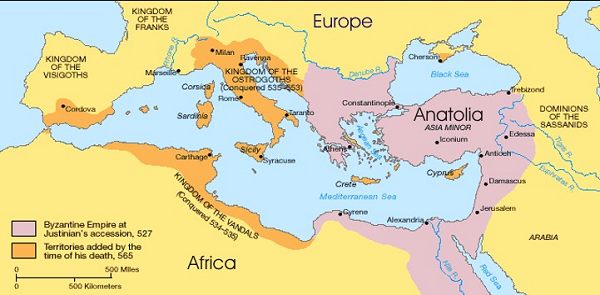 Equally bureaucratic was the Byzantine Empire, with the emperor also afforded divine status. During its first three centuries of its existence, the empire followed the systems established by Diocletian and Constantine, where civil and military duties were kept strictly apart, and offices were based on membership or not of the Senate. With the loss of territories to Islam, the senatorial class remained in place, but a new, more court-centered system emerged, supported by a nobility that was either metropolitan based or provincial, the last having large land holdings but no military forces of their own. The aristocracy became more important in later centuries, where a comparatively small number of families (80 civil and 64 military) bound the empire together. {34} {34}
Equally bureaucratic was the Byzantine Empire, with the emperor also afforded divine status. During its first three centuries of its existence, the empire followed the systems established by Diocletian and Constantine, where civil and military duties were kept strictly apart, and offices were based on membership or not of the Senate. With the loss of territories to Islam, the senatorial class remained in place, but a new, more court-centered system emerged, supported by a nobility that was either metropolitan based or provincial, the last having large land holdings but no military forces of their own. The aristocracy became more important in later centuries, where a comparatively small number of families (80 civil and 64 military) bound the empire together. {34} {34}
Protocol were as exact and intricate as those of Imperial China, and court life passed 'in a sort of ballet', with precise ceremonies prescribed for every occasion — to show that 'imperial power could be exercised in harmony and order' and 'reflect the motion of the Universe as it was made by the Creator'. Again as in China, eunuchs bcame increasingly important, even drawing their members from the ranks of the aristocracy. {34}
Byzantine coinage also forms a very regular series: a gold solidus and a copper nummus (generally 40 nummi making the follis), both reformed by Aanastasius in 498. A silver hexagram and miliaresion were struck only occasionally. The solidus underpinned international trade and remained of good design and fineness until the 11th century. {35-39} Though Byzantium was not a theocracy, {36} the gold coinage does reflect the ornate and hierarchical appeal to heavenly authority.
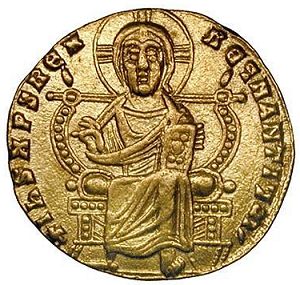 | Leo VI AV Solidus. Constantinople, ca 908-912 AD. +IhS XPS REX REgNANTIUM, (Christ Pantaucrator King of Kings) Christ seated facing in lyre-backed throne, raising right hand in benediction & holding Gospel in left, CONOB in exergue |
 | LEOh ET COhSTANT' AUgg' ROM, (Leo and Constantine, Roman Augusti) Leo VI & Constantine IV standing facing, both crowned and wearing loros, each holding cross on globe, patriarchal cross beween them. Sear 1725; DOC 2. |
The copper coinage is much more functional, and the 40 nummia follis and its fractions were issued through to the 12th century, when the assaria, tournesia and follara make their appearance. {37, 40} {35, 37}
| | Justinian I, Ae Follis. Constantinople. 527-565 AD. DN IVSTINIANVS PP AVG (Our Lord Justinian, Perpetual Augustus), helmeted, cuirassed bust facing holding cross on globe and shield; cross to right |
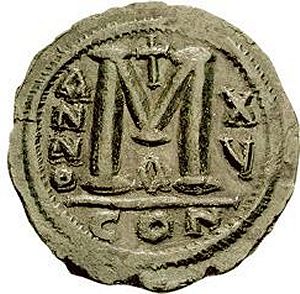 | Large M, ANNO to left, cross above, regnal year to right, (40: year 15) officina letter below, mintmark CON (Constantinople) . (132 known combinations). SB 163, DOC 37-61. |
References and Further Reading
Need the 40 references and 7 illustration sources? Please consider the modestly-priced ebook.

